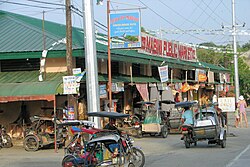Mabini Balincaguin | |
|---|---|
| Municipality of Mabini | |
 Fields in Mabini | |
 Map of Pangasinan with Mabini highlighted | |
Location within the Philippines | |
| Coordinates: 16°04′11″N119°56′24″E / 16.06972°N 119.94°E | |
| Country | Philippines |
| Region | Ilocos Region |
| Province | Pangasinan |
| District | 1st district |
| Founded | 1923 |
| Named after | Apolinario Mabini |
| Barangays | 16 (see Barangays) |
| Government | |
| • Type | Sangguniang Bayan |
| • Mayor | Colin A. Reyes |
| • Vice Mayor | Darius P. Bonalos |
| • Representative | Arthur F. Celeste |
| • Municipal Council | Members |
| • Electorate | 18,157 voters (2025) |
| Area | |
• Total | 291.01 km2 (112.36 sq mi) |
| Elevation | 51 m (167 ft) |
| Population (2024 census) [3] | |
• Total | 26,589 |
| • Density | 91.368/km2 (236.64/sq mi) |
| • Households | 6,650 |
| Economy | |
| • Income class | 3rd municipal income class |
| • Poverty incidence | 23.3 |
| • Revenue | ₱ 214.1 million (2022) |
| • Assets | ₱ 389.8 million (2022) |
| • Expenditure | ₱ 139.7 million (2022) |
| • Liabilities | ₱ 25.18 million (2022) |
| Service provider | |
| • Electricity | Pangasinan 1 Electric Cooperative (PANELCO 1) |
| Time zone | UTC+8 (PST) |
| ZIP code | 2409 |
| PSGC | |
| IDD : area code | +63 (0)75 |
| Native languages | Pangasinan Ilocano Sambal Tagalog |
| Website | www |
Mabini, officially the Municipality of Mabini (Pangasinan : Baley na Mabini; Ilocano : Ili ti Mabini; Tagalog : Bayan ng Mabini), is a municipality in the province of Pangasinan, Philippines. According to the 2024 census, it has a population of 26,589 people. [5]
Contents
- History
- Geography
- Barangays
- Climate
- Demographics
- Economy
- Government
- Local government
- Elected officials
- List of municipal mayors
- Education
- Primary and elementary schools
- Secondary schools
- Notable personalities
- Gallery
- See also
- References
- External links
The municipality was formerly called Balincaguin. [6]






